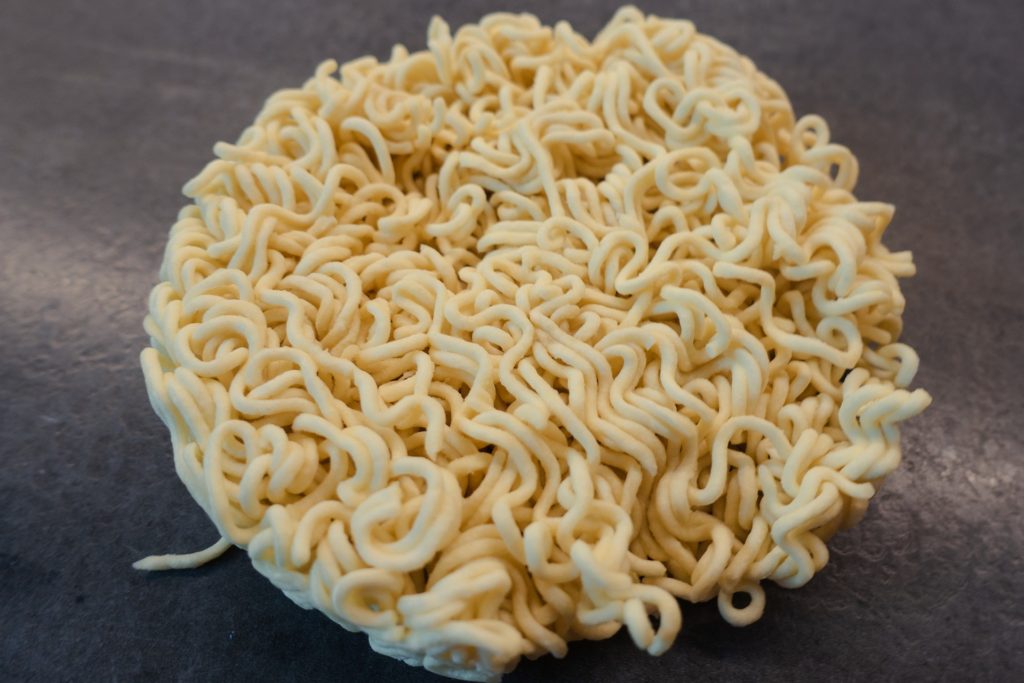

Disodium inosinate or IMP (E631) is a flavor enhancer and the disodium salt of inosinic acid. It also goes by other names such Disodium inosine-5′-monophosphate, Disodium 5′-inosinate, and 5′-inosinic acid. Like other flavor enhancers, IMP has no particular taste on its own, but has the ability to enhance existing flavors in food.
Disodium inosinate appears as white or colorless granular powder. It is soluble in water, but sparingly soluble in ethanol. Its pH level is between 7.0 and 8.5. It is highly stable 212°F (100°C) and will not decompose until the temperature reaches 446°F (230°C).
IMP imparts meaty, and savory or umami taste in food products such as instant noodles (seasoning), potato chips, canned soups, condiments, and snacks. If you wonder why processed foods and fast food items can be addicting sometimes, disodium inosinate may be the reason for it.
Disodium inosinate is seldomly used alone as a food enhancer. But is often added in synergy with other flavor enhancers such as disodium guanylate (GMP) and monosodium glutamate (MSG). One reason is that disodium inosinate is a relatively expensive ingredient. Another is that its flavor enhancing flavor is 50% of than of GMP. However, the most important reason is how the combination makes foods taste much better than that with MSG and/or GMP alone.
When IMP is mixed with GMP in a 1:1 ratio, the combination becomes disodium 5′-ribonucleotides or (E635). It is also known as I+G, and is added directly into foods. It is relatively low cost and effective. For this reason, it is the main flavor ingredient in products such as chicken powder, soy sauce, and instant noodle seasoning. Furthermore, the flavor enhancing ability of the combination of 98% MSG and 2% I+G is four times stronger than than with MSG alone.
Disodium inosinate is generally produced from animal sources, mainly chicken or fish. Hence, inosinates from animal sources are not suitable for vegan and vegetarians. In case it is made from plant sources such as tapioca starch, the producer may label it as “vegetarian” in the ingredients list.
Disodium inosinate is also produced by bacterial fermentation of sugars. This patent describes how inosinic acid productivity can be enhanced by using a genetically-modified bacterium under the genus Escherichia.
The resulting product is then reacted with phosphoryl chloride to produce inosinic acid, which is then neutralized to obtain disodium inosinate.
Another way of producing IMP is through yeast extract. Yeast extract is a condensate of flavor substances (inosinates) and soluble nutrients. These can be absorbed by our body. They can also be prepared by degradating proteins in yeast cells. This patent describes a method of a yeast extract containing 4-30% IMP and GMP.
Like other food additives, IMP have been studied and reviewed by various organizations regarding its safety.
In the United States, the Food and Drug Administration has approved the use of disodium inosinate in food, provided that the flavor enhancer contains no more than 150 parts per million of soluble barium with seven and one-half molecules of water of crystallization.
Additionally, a FDA committee found no evidence of carcinogenity and teratogenecity during a conduct of review of literature.
In Europe, the European Food Safety Authority (EFSA) delivered a scientific opinion on the safety and efficiency of IMP when used as a flavor enhancer in feed and drinking water for all animal species. The IMP was produced through fermentation using a non-genetically modified strain of Corynebacterium stationis. The opinion revealed that IMP does not raise safety concerns for the animal species, the consumers, and the environment. As for the efficacy of IMP in enhancing flavors, the panel believed that its effect is well documented. Thus, there was no need for further documentation.
Australia, New Zealand, and UK food standards have declared IMP as a safe additive in food.
The Scientific Committee for Food (1993) and the Joint WHO/FAO Expert Committee on Food (1973, 1993) have also evaluated IMP, which is currently an authorized food additive under the E number E631.
No acceptable daily intake (ADI) has been specified. However, IMP may not be added to food products intended for children under 12 weeks.
IMP is also found in tissues of plants and animals. It plays its part in purine metabolism and breakdown to uric acid in the body. Therefore, people suffering from gout must minimize consuming IMP-containing foods. Although its concentration in food are generally low, so side effects are not expected.
Flavor enhancers such as IMP and MSG are GRAS (generally recognized as safe). However, there are several reports of individuals experiencing allergic reactions with symptoms such as shortness of breath, chest tightness, and skin rash. In case an individual experiences these, it is best to steer clear from trigger foods.